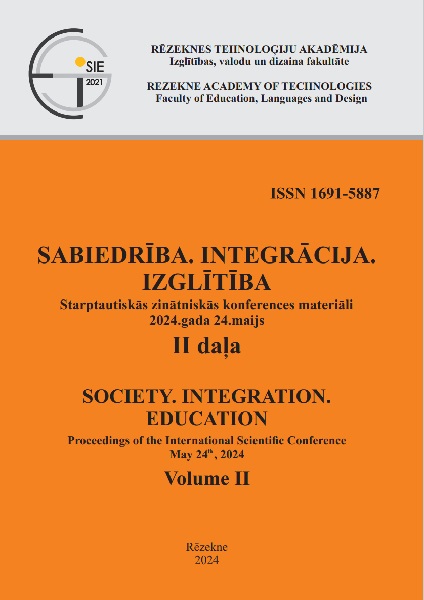THE INFLUENCE OF BODY POSITION ON THE SPEED OF A SIDE KICK IN KICKBOXING
DOI:
https://doi.org/10.17770/sie2024vol2.7820Keywords:
force platform, kickboxing, side kick, support reaction force, upper body positionAbstract
Kickboxing is a combat sport where two types of fights occur: light-contact and full-contact. There is no limitation on the strength of kicks and punches in the latter type. In martial arts, athletes try to hit an opponent with as much speed and power as. The position of the upper body is indicated as the most important factor directly influencing the performance of the kicks. The aim of the research: to determine the effect of a change in the position of the upper body of a 14-16-year-old kickboxer on the time of execution of the side kick with the foot placed in front and the ground reaction force in the place, moving forward and in the counterattack, determining the time of the side kick and the ground reaction force of the take-off foot in three different upper body positions to give the execution time of each type of side kick and the ground reaction force of the take-off foot. The fastest side kick with the forward foot in place and moving forward will be in the upper body position 45° to the vertical axis, but performing side kick with the forward foot in counterattack and side kick moving forward from the position of the upper body 90˚ against the vertical axis was partially proved.
References
Ambroży, T., Rydzik, Ł., Kędra, A., Ambroży, D., Niewczas, M., Sobiło, E., & Czarny, W. (2020). The effectiveness of kickboxing techniques and its relation to fights won by knockout. Arch. Budo, 16, 11-17.
Belykh, S. I., & Oleynik, O. S. (2019). Kick as key combat technique for success in kickboxing. Theory and Practice of Physical Culture, (4), 27-27.
Boyat, A. K., Singh, A., & Sandhu, J. S. (2017). The kinematics analysis of preferred and non-preferred roundhouse kick according to stance position in Indian taekwondo players. International Journal of Therapies and Rehabilitation Research, 6(2), 181. doi: 10.5455/ijtrr.000000261
Estevan, I., Falco, C., & Jandacka, D. (2011). Mechanical analysis of the roundhouse kick according to the stance position. A pilot study. In ISBS-Conference Proceedings Archive.
Estevan, I., Jandacka, D., & Falco, C. (2013). Effect of stance position on kick performance in taekwondo. Journal of sports sciences, 31(16), 1815-1822. doi: https://doi.org/10.1080/02640414.2013.803590
Falco, C., Estevan, I., & Vieten, M. (2011). Kinematical analysis of five different kicks in taekwondo. In 29th International Conference on Biomechanics in Sports. 219-222. ISSN 1999-4168
Fortier, S., Basset, F. A., Mbourou, G. A., Favérial, J., & Teasdale, N. (2005). Starting block performance in sprinters: a statistical method for identifying discriminative parameters of the performance and an analysis of the effect of providing feedback over a 6-week period. Journal of sports science & medicine, 4(2), 134.
Grassie, K. P. (2017). Kinematics of the Lower Extremities during Fundamental Martial Arts Tricking Techniques. Honors Scholar Theses. 522.
Gulledge, J. K., & Dapena, J. (2008). A comparison of the reverse and power punches in oriental martial arts. Journal of sports sciences, 26(2), 189-196. doi: https://doi.org/10.1080/02640410701429816
Jandačka, D., Estevan, I., Janura, M., & Falco, C. (2013). The impact of the initial stance position on lower limb joint kinetics in the taekwondo roundhouse kick. Acta Gymnica, 43(2), 15-22. doi: 10.5507/ag.2013.008
Kim, Y. K., Kim, Y. H., & Im, S. J. (2011). Inter-joint coordination in producing kicking velocity of Taekwondo kicks. Journal of sports science & medicine, 10(1), 31.
Lee, J. H., Lee, Y. S., & Han, K. H. (2008). A study on impact analysis of side kick in Taekwondo. International Journal of Modern Physics B, 22(09n11), 1760-1765. doi: https://doi.org/10.1142/S0217979208047389
Ouergui, I., Hssin, N., Franchini, E., Gmada, N., & Bouhlel, E. (2013). Technical and tactical analysis of high level kickboxing matches. International Journal of Performance Analysis in Sport, 13(2), 294-309. doi: https://doi.org/10.1080/24748668.2013.11868649
Pędzich, W., Mastalerz, A., & Urbanik, C. (2006). The comparison of the dynamics of selected leg strokes in taekwondo WTF. Acta of Bioengineering and Biomechanics, 8(1), 83-90.






